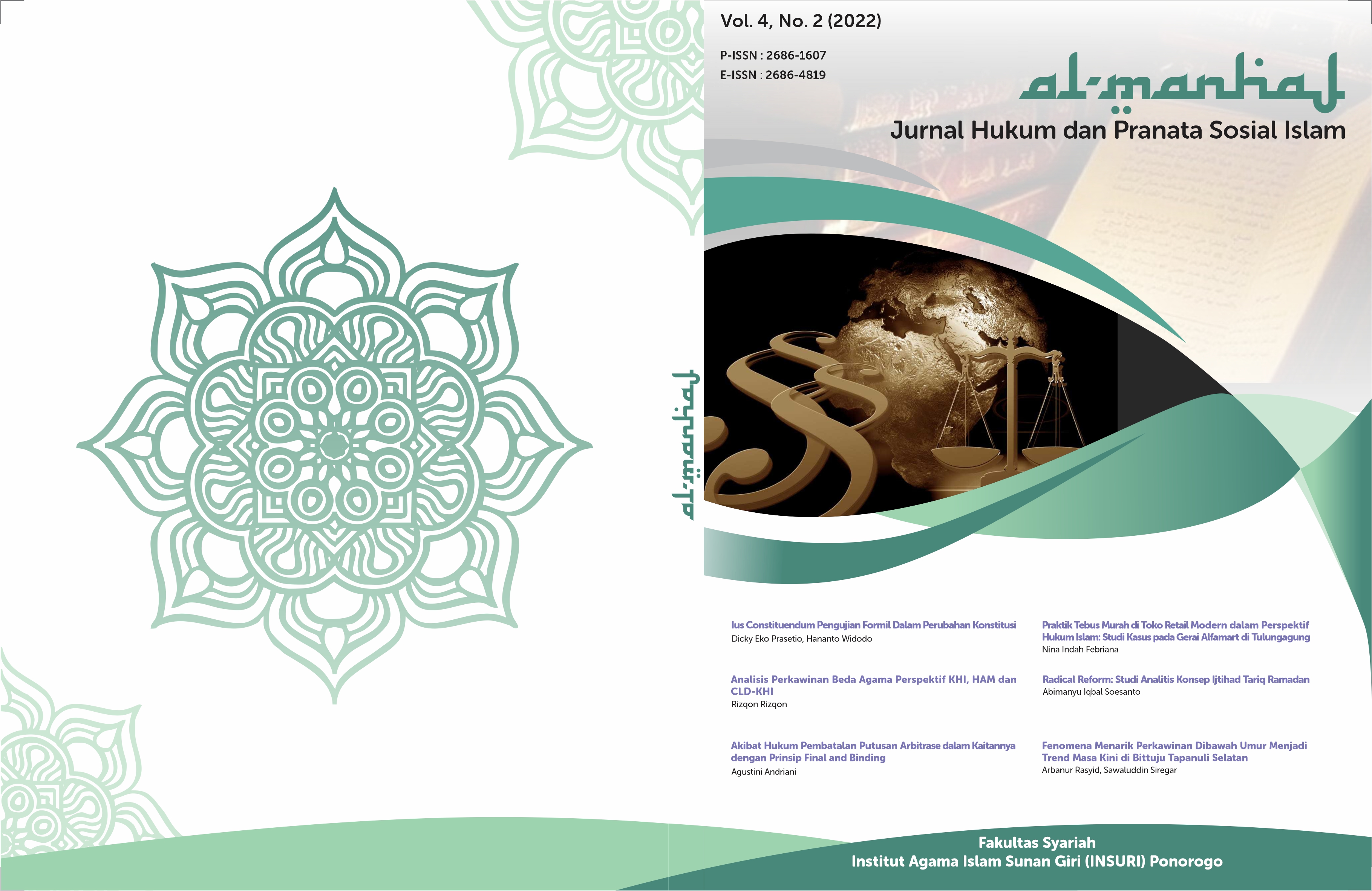Praktek Predatory Pricing dalam Perspektif Maqashid Syariah
DOI:
https://doi.org/10.37680/almanhaj.v4i1.1580Keywords:
Predatory Pricing, Maqasid Syaria, Economic MonopolyAbstract
Export and import activities cannot be denied by a country in order to meet the needs of its people, as well as a means of development, especially to increase the export aspect of state products. Competition is something that cannot be avoided from every country in seizing international market share and even world market share. Competition is not only carried out in a healthy manner, sometimes even in an unhealthy way, such as selling products at prices above the market price in general, even selling below a fair price with the aim of seizing market share and causing damage to market mechanisms, one of which is by conducting predatory pricing practices price. This unhealthy practice makes MSME actors and domestic industries feel disadvantaged, it will even have a negative impact on the economy of a country. This study is to see predatory pricing practices in the eyes of maqahid sharia using the pheno approach which is currently being sought after by MSME activists. The method used is descriptive analysis as an effort to solve problems by describing and explaining predatory pricing and its relationship with sharia maqashid. In the view of Islamic economics, the term predatory pricing is known as إغراق (ighraq), and Islam forbids ighraq because it is a trade practice that contains harm.
References
Alhayat, A. (2014). The Effectiveness of Anti-Dumping Action in Indonesia 1996-2010. 5, 247–268.
Anggraeni, N. (2015). Dumping Dalam Perspektif Hukum Dagang Internasional Dan Hukum Islam.
Arie Rachmat Sunjoto. (2019). Strategi Kebijakan Pembangunan Ekonomi Dalam Perspektif Islam (Studi. Islamic Economic Journal, 4.
Arif, H. (2019). Mekanisme Pasar Dalam Perspektif Ekonomi Islam. IQTISHADIA: Jurnal Ekonomi & Perbankan Syariah, 28(3), 535. https://doi.org/10.32678/alqalam.v28i3.889
Arif, M. (2018). Filsafat Ekonomi Islam (Vol. 1). UIN-SU Press.
Febriana, R. (2017). Dampak Predatory Pricing Yang Dilakukan Pelaku Usaha Dalam Perspektif Persaingan Usaha.
Giocoli, N. (2014). Predatory Pricing in Antitrust Law and Economics. Routledge.
Kartajaya, H., & Sula, M. S. (2016). Syariah Marketing. Mizan Pustaka.
KNEKS, E. (2019). Strategi Pengembangan Keuangan Mikro Syariah Di Indonesia. KNEKS.
Maskuroh, N. (2017). Monopoli Rent-Seeking Dan Dumping Policy Dalam Etika Bisnis. 8(2), 189–212.
Novi, M. (n.d.). Konsep Fintech Lending Dalam Perspektif Maqāsid Syarī’ah. Islamic Economic Journal, 6(1).
Prusa, T. J. (2020). The Trade Effects of U.S. Antidumping Actions. In Economic Effects of Antidumping: Vol. Volume 77 (pp. 21–43). WORLD SCIENTIFIC. https://doi.org/doi:10.1142/9789811225253_0003
Setiawati, S. D., Retnasari, M., & Diny Fitriawati. (2019). Strategi membangun branding bagi pelaku Usaha Mikro Kecil Menengah. JURNAL ABDIMAS BSI Jurnal Pengabdian Kepada Masyarakat Vol., 2(1), 125–136.
Sugiyono. (2017). Metode Penelitian Bisnis. Alfabeta.
Ulum, F. (2004). Sejarah Pemikiran Ekonomi Islam (Analisis Pemikiran Tokoh dari Masa Rasulullah SAW Hingga Masa Kontemporer) Buku. Prodi HES Fakutas Syariah UINSA.
Downloads
Published
How to Cite
Issue
Section
License
Copyright:
- Author retains the copyright and grants the journal the right of first publication of the work simultaneously licensed under a Creative Commons Attribution 4.0 International License that allows others to share the work with an acknowledgment of the work's authorship and initial publication in this journal.
- Author is able to enter into separate, additional contractual arrangements for the non-exclusive distribution of the journal's published version of the work (e.g., post it to an institutional repository or publish it in a book) with the acknowledgment of its initial publication in this journal.
- Author is permitted and encouraged to post his/her work online (e.g., in institutional repositories or on their website) prior to and during the submission process, as it can lead to productive exchanges, as well as earlier and greater citation of the published work (See The Effect of Open Access).
License:
-
Attribution — You must give appropriate credit, provide a link to the license, and indicate if changes were made. You may do so in any reasonable manner, but not in any way that suggests the licensor endorses you or your use.
-
No additional restrictions — You may not apply legal terms or technological measures that legally restrict others from doing anything the license permits.
You are free to:
- Share — copy and redistribute the material in any medium or format
- Adapt — remix, transform, and build upon the material for any purpose, even commercially.

This work is licensed under a Creative Commons Attribution 4.0 International License.














